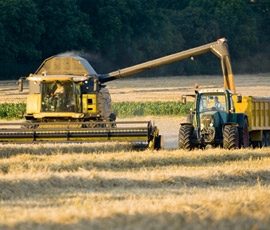Variety choice blamed for poor wheat quality

Later maturing wheat varieties have lower specific weights than those that ripen earlier, making their popularity partly responsible for the grain quality challenges experienced in 2012, according to HGCA analysis.
The findings mean that last year’s poor grain quality results can’t be blamed entirely on disease pressure or the appalling weather, reports Ellie Marshall, HGCA’s research and KT manager for plant breeding and genetics, who carried out the latest analysis on five years of data.
“This time last year, grain quality took a well-publicised dive and there’s little doubt that the 2012 season had a big effect on specific weight,” she says. “But while the weather and resulting disease pressure played their part in its fall, we’ve seen that other factors had a bearing too.”
Fungicide use, variety choice and location all made a difference, suggest the results, with the focus now turning to the ripening time of varieties and the implications of maturity on specific weight.
“What we’ve generally seen in the last five to six years is better yield performance from later maturing varieties, because the seasons have tended to favour their longer grain fill period,” she explains.
As a result, there’s been a swing to these later types and more interest in them, both from growers and plant breeders, she adds. “If you look at the current Recommended List, there are 18 varieties classed as late (+1,+2) and five classed as very late (+3,+4), which represent two-thirds of the total line-up.”
That compares to just 11 varieties classed as timely (0) or early (-1,-2) – only one-third of the list. “Five years ago, it was the other way round.”
But that move has had a significant effect on grain quality – not just in a “bad” year, but taking the last five years into account, stresses Dr Marshall.
“There are significant differences between ripening groups. And the earlier varieties have higher specific weights.”
Data from two sources was investigated – the Recommended List and the Cereal Quality Survey, she explains. “So we have the results from commercial crops, as well as a trials situation. And we have it going back for the last five years, rather than just for the year that everyone remembers.”
Specific weight thresholds vary according to the intended use of the grain, she points out. “For bread-making, it has to be at 76kg/hl, while for biscuit and cake flour, it needs to be 74kg/hl. The feed threshold is 72kg/hl.”
Below this 72 level, the grain trade tends to impose penalties, she notes. “The reason for that is that thin, shrivelled grain won’t mill to give adequate amounts of clean, white flour.”
The massive drop experienced in 2012 affected all crops, although it was worse in commercial situations. “Remember that the RL protocol involves a very robust fungicide programme, effectively eliminating disease pressure, so it’s not surprising that specific weights fell less in the trials.”
Even so, the RL data did mirror the commercial situation with lower specific weights, so disease could not be the only factor, she stresses.
Furthermore, all four Nabim groups saw a drop. “Nothing escaped. It was a problem across all varieties.”
Regional analysis shows that crops grown in the Midlands tend to have the highest specific weights, while those from the South West and Scotland are the lowest – probably as a result of higher disease pressure.
“The 2012 data did show up some anomalies,” reports Dr Marshall. “Compared with 2011, when grain quality was very good, there was a huge drop. However, there was less of a drop in Scotland, while one of the biggest falls was in the Midlands. The South West also had some of the lowest specific weights around.”
The relationship between rainfall and specific weight was also investigated, to see whether high rainfall years have had an effect.
“Both 2008 and 2012 were high rainfall years,” she reveals. “In 2008, we recorded high yields, with no significant change in specific weight. In 2012, we had low yields and low specific weights. So the two high rainfall years resulted in different specific weights.”
A closer look at the weather in those two years shows that 2008 experienced optimal conditions, with low rainfall and mild temperatures at flowering, but followed by high sunlight hours during growth and grain filling.
In contrast, 2012 had high rainfall and low sunlight during growth and grain filling, which followed a wet and dark April – the cause of low grain number.
“Scotland, however, did have longer days and more sunshine, which is why crops didn’t suffer to quite the same extent.”
So far, 2013 looks more promising, she believes. “The grain number is set in April, with the critical months being June and July. We had both sunshine and moisture earlier on this year, so crops are looking good.”
Simon Oxley of HGCA believes that growers should be aware of variety ripening time and the link between lateness and low specific weight.
“Yield is very important, but growers mustn’t lose sight of other agronomic factors. We don’t want to end up with a whole host of very late varieties, and no other options.”
Having a range of maturities is a sensible approach, he suggests. “It allows you to manage harvest and there’s always the option to blend varieties with different specific weights, so that you meet specification.”
Growers want high yielding varieties that remain standing, he adds. “Then they have to decide how important specific weight is to them. If it matters and low values are going to result in penalties, they should be aware that later varieties have inherently low specific weight.”

